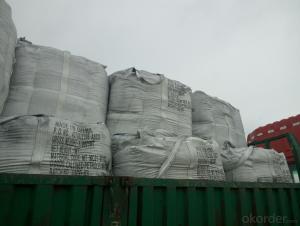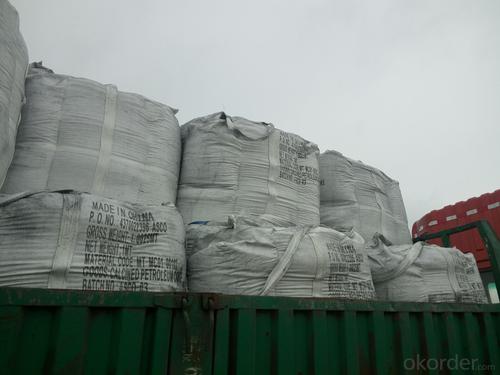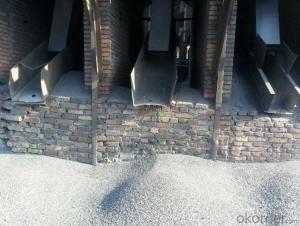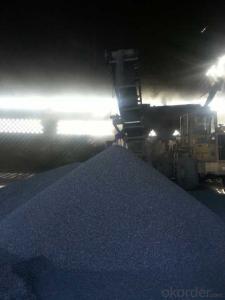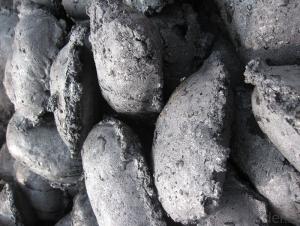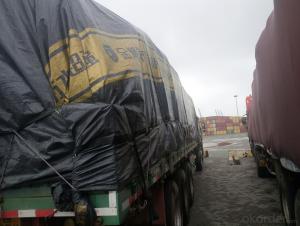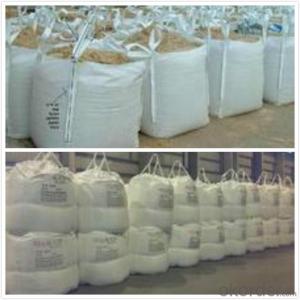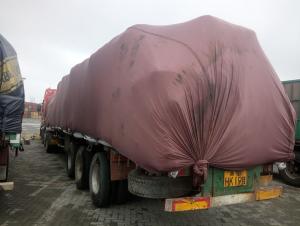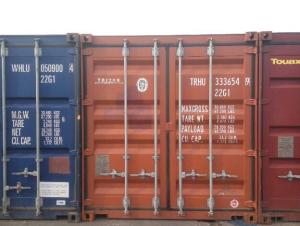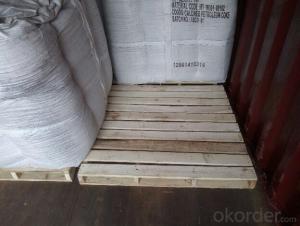Calcined Pitch Coke for Steel-Making company
- Loading Port:
- Tianjin
- Payment Terms:
- TT OR LC
- Min Order Qty:
- 21 m.t.
- Supply Capability:
- 8000 m.t./month
OKorder Service Pledge
OKorder Financial Service
You Might Also Like
Introduction
Pitch Coke/Coal Tar Pitch is a kind of black brittleness and blocky piece, lustrously at normal temperature. It has special odour and poisonous and can be easily flame when melting, second-grade inflammable solid.
Pitch Coke/Coal Tar Pitch is obtained from powerfully processed coal tar. Compared to petroleum asphalt, the adhesiveness is better. Coal Tar Pitch is high quality tar production with high fixed carbon. It has excellent adhesion, waterproofing and resistance against seawater, oil and various chemicals. In these properties, it is much better than petroleum asphalt tar.
It can be used to produce painting, electrode, pitch coke, and tar felt. It also can be used as fuel and the raw material of asphalt carbon black.
Features:
The morphology, chemistry and crystallinity of recarburisers have a major impact on the overall casting cost. The combined application and cost benefits, which are derived through the use of Desulco, enable foundries to manufacture castings in a highly cost effective manner.
reduces
Recarburiser consumption
Power consumption
Inoculant consumption
MgFeSi consumption
Furnace refractory wear
Scrap rate
Tap to tap time
Slag inclusions risk
Chill
increases
Casting microstructure
Productivity
Process consistency
Carbon Recovery
Compared with calcined petroleum coke, acetylene coke and
graphite electrode scrap, Desulco yields the highest carbon
recovery and fastest dissolution time
Specifications:
CPC | |||
F.C.% | 98.5MIN | 98.5MIN | 98MIN |
ASH % | 0.8MAX | 0.8MAX | 1MAX |
V.M.% | 0.7 MAX | 0.7 MAX | 1 MAX |
SULFUR % | 0. 5MAX | 0. 7MAX | 1MAX |
MOISTURE % | 0.5MAX | 0.5MAX | 1MAX |
Pictures:
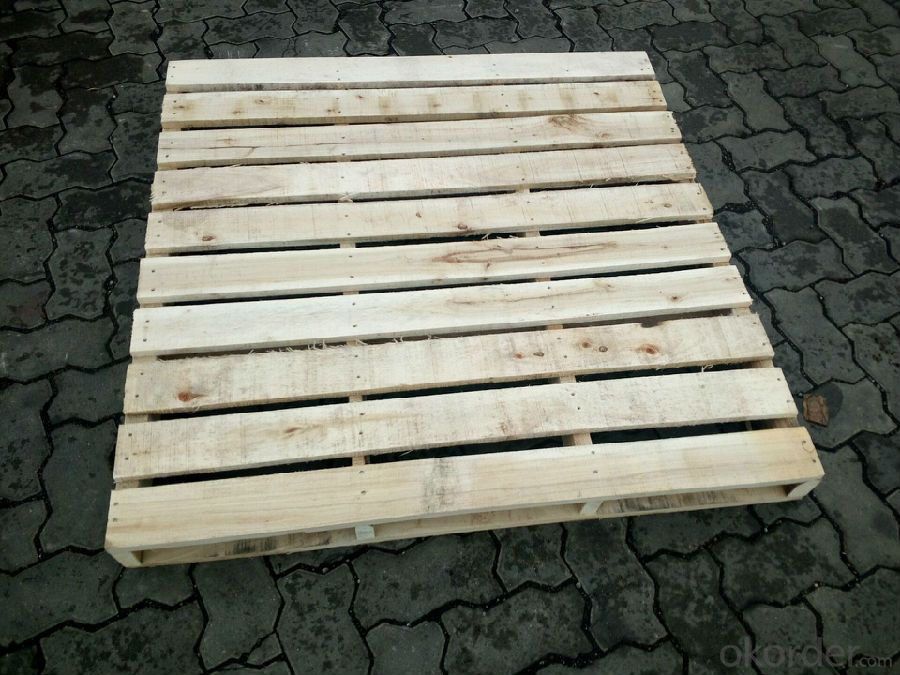
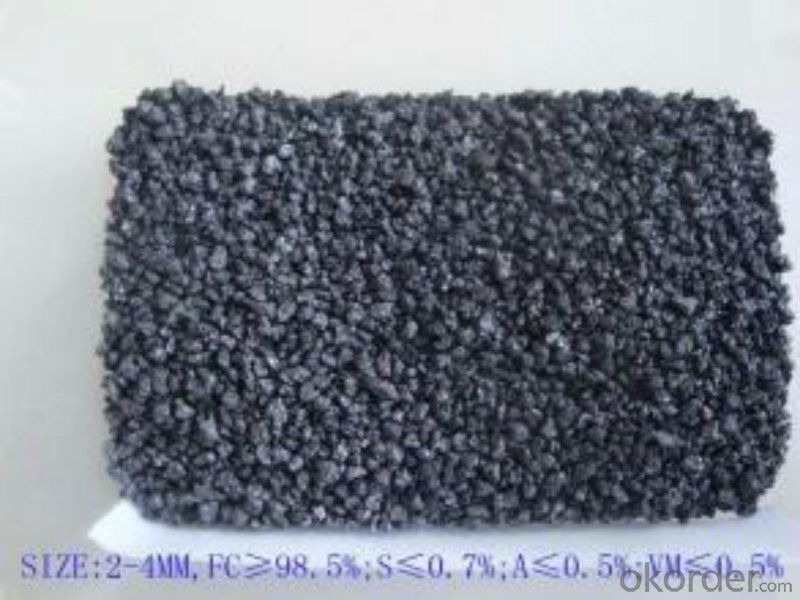

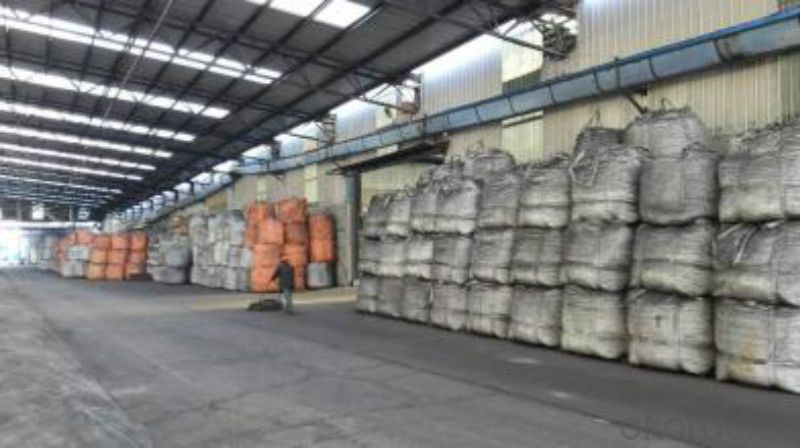
FAQ:
1.MOQ:2 Containers |
2.Size:1-3mm,1-5mm,2-6mm,3-5mm and as the customer's requirement |
3.Packing: 1 ton jumbo bag or 25kgs paper in bag |
4.Payment:T/T or L/C at sight |
5.Delivery time: within 15 days after receiving the deposit |
6.Usage: it is as carbon raiser,widely used in steelmaking,casting,casting iron,steel foundry,aluminum metallury. |
- Q: How does carbon affect the formation of heatwaves?
- Carbon dioxide, a greenhouse gas, plays a significant role in the formation of heatwaves. When carbon dioxide is released into the atmosphere through human activities such as burning fossil fuels and deforestation, it acts as a blanket, trapping heat from the sun and preventing it from escaping back into space. This phenomenon is known as the greenhouse effect. As carbon dioxide levels continue to rise, the Earth's temperature also increases, leading to more frequent and intense heatwaves. The excess heat trapped in the atmosphere creates a feedback loop, further exacerbating the problem. Heatwaves occur when high-pressure systems stall over a region for an extended period, causing temperatures to soar well above average. Carbon not only influences the intensity of heatwaves but also their duration. The increased greenhouse effect prolongs the time during which heatwaves persist, making them more dangerous and damaging. This prolonged exposure to extreme heat can have severe consequences on human health, leading to heat-related illnesses, increased mortality rates, and reduced productivity. Furthermore, carbon emissions contribute to climate change, which alters weather patterns and leads to more extreme events like heatwaves. Climate models project that heatwaves will become more frequent, longer-lasting, and intense in the future if carbon emissions are not significantly reduced. Addressing the issue of carbon emissions is crucial in mitigating the impacts of heatwaves. Transitioning to cleaner and renewable energy sources, implementing energy efficiency measures, and promoting reforestation efforts are some of the steps that can be taken to reduce carbon dioxide levels. By doing so, we can mitigate the formation of heatwaves and protect both human health and the environment.
- Q: What are the consequences of increased carbon emissions on forest ecosystems?
- Increased carbon emissions have significant consequences on forest ecosystems. One of the most notable impacts is the alteration of the climate and weather patterns. The excessive carbon dioxide in the atmosphere traps heat, leading to global warming. This rise in temperature can disrupt the delicate balance of forest ecosystems. Warmer temperatures can cause shifts in the distribution and composition of tree species, as some may struggle to adapt to the changing conditions. Another consequence of increased carbon emissions is the acidification of rainwater. When carbon dioxide combines with water vapor, it forms carbonic acid, which can fall as acid rain. Acid rain has detrimental effects on forest ecosystems, as it leaches important nutrients from the soil and damages tree leaves and other vegetation. This can weaken the overall health of the forest and make them more susceptible to diseases and pests. Furthermore, increased carbon emissions contribute to the intensification of wildfires. Higher temperatures and drier conditions provide the perfect environment for fires to spread and become more frequent. Forests that have evolved to withstand natural fire regimes may struggle to cope with the increased intensity and frequency of these fires. This can lead to the loss of biodiversity, destruction of habitat, and long-term degradation of forest ecosystems. Lastly, increased carbon emissions contribute to the phenomenon known as ocean acidification, where excess carbon dioxide is absorbed by the oceans. This acidification can affect the health of coastal and marine ecosystems, which are intricately connected to forest ecosystems. Many forest ecosystems, such as mangroves and salt marshes, provide vital nursery habitats for marine species. If these forest ecosystems decline due to carbon emissions, it can have cascading effects on the health and productivity of coastal and marine ecosystems. Overall, increased carbon emissions have far-reaching consequences on forest ecosystems. It alters climate patterns, causes acid rain, intensifies wildfires, and affects coastal and marine ecosystems. These impacts not only harm the trees and vegetation within the forests but also disrupt the delicate balance of the entire ecosystem, leading to loss of biodiversity and long-term degradation. It is crucial to mitigate carbon emissions and promote sustainable practices to minimize these consequences and preserve the health and integrity of forest ecosystems.
- Q: What are the impacts of carbon emissions on the stability of deserts?
- Carbon emissions have significant impacts on the stability of deserts. One of the key consequences is the exacerbation of desertification, which refers to the process of fertile land turning into desert due to various factors, including climate change. Carbon emissions contribute to global warming, leading to higher temperatures and increased evaporation rates, which in turn result in reduced soil moisture and increased aridity in desert regions. This intensifies the process of desertification, causing deserts to expand and become more unstable. Furthermore, carbon emissions contribute to the alteration of precipitation patterns, which directly affects the stability of deserts. As climate change leads to shifts in weather patterns, some areas may experience reduced rainfall, while others may face more frequent and intense droughts. These changes in precipitation can further exacerbate desertification processes and lead to increased desert instability. Another impact of carbon emissions on desert stability is the increased frequency and intensity of dust storms. As global warming leads to drier conditions and reduced vegetation cover, the risk of dust storms becomes higher. These storms can transport vast amounts of fine particulate matter, including dust and sand, over long distances, resulting in a range of negative consequences. Dust storms can damage infrastructure, harm human health, degrade air quality, and further contribute to desertification processes by removing fertile topsoil. Additionally, the impacts of carbon emissions on deserts are not limited to their ecological stability but also have socio-economic implications. Many communities in desert regions rely on agriculture and natural resources for their livelihoods. The destabilization of deserts due to carbon emissions can lead to reduced agricultural productivity, increased food insecurity, and economic hardship for these communities. Moreover, the displacement of people from desert regions due to desertification can lead to increased migration and social instability. In conclusion, carbon emissions have far-reaching impacts on the stability of deserts. They contribute to the intensification of desertification processes, alter precipitation patterns, increase the frequency and intensity of dust storms, and have socio-economic consequences. Addressing carbon emissions through climate change mitigation strategies is crucial to minimize these impacts and ensure the long-term stability of desert ecosystems and the communities that depend on them.
- Q: What are the different types of carbon-based plastics?
- There are several types of carbon-based plastics, including polyethylene (PE), polypropylene (PP), polyvinyl chloride (PVC), polystyrene (PS), and polyethylene terephthalate (PET). Each of these plastics has unique properties and applications, making them suitable for various industries and products.
- Q: What is carbon offsetting in the food industry?
- The concept of carbon offsetting within the food industry involves the act of counteracting or compensating for the greenhouse gas emissions associated with the processes of food production and distribution. It serves as a means for food companies to take responsibility for their carbon footprint and make a contribution towards global endeavors in mitigating climate change. Significant contributions to greenhouse gas emissions originate from activities related to food production and distribution, primarily including deforestation, alterations in land use, energy consumption, and transportation. Through carbon offsetting, food industry companies are able to invest in projects or initiatives aimed at reducing or eliminating an equal quantity of carbon dioxide from the atmosphere, effectively balancing out their own emissions. Within the food industry, there exist various approaches to carbon offsetting. A frequently employed method involves investment in renewable energy projects, such as wind farms or solar power installations, which counterbalance emissions arising from energy consumption within food processing facilities or during transportation. Another method involves providing support for projects aimed at promoting sustainable agricultural practices, such as reforestation or afforestation endeavors, which contribute to the capture of carbon dioxide from the atmosphere. The practice of carbon offsetting within the food industry also extends to the realm of supply chain management. Companies are able to collaborate with their suppliers in order to implement more sustainable farming practices, minimize waste, and optimize transportation routes, all with the intention of reducing emissions. By engaging with farmers, producers, and distributors, food companies can collectively strive towards reducing their overall carbon footprint and attaining carbon neutrality. It should be recognized that carbon offsetting is not intended to serve as a substitute for reducing emissions at their source. Rather, it should be seen as a supplementary measure, supporting the transition towards more sustainable and low-carbon practices within the food industry. Through offsetting their emissions, food companies are able to demonstrate their commitment to environmental stewardship and contribute to the global fight against climate change.
- Q: 14 is the upper left corner of the mark, please answer a bit more detailed, thank you!
- Enter 14C, select "14", "point font" or "tool" button "superscript"".
- Q: What kind of industry does high-performance carbon fiber belong to?
- High performance carbon fiber is used in many industries, such as automobiles, bicycles, and even the aviation industry.. If you look at the industry type, many industries have high-performance carbon fiber figure, if divided by the industry attributes, should belong to the emerging industry, the future potential of the industry
- Q: How are carbon nanotubes used in various industries?
- Carbon nanotubes have found applications in numerous industries due to their incredible versatility. With their unique properties, they are ideal for a wide range of uses. In the electronics industry, carbon nanotubes enhance the performance of electronic devices. They act as conductive additives in polymers, improving electrical conductivity. This makes them suitable for flexible displays, touchscreens, and wearable electronics. Moreover, carbon nanotubes serve as field emitters in flat-panel displays, resulting in brighter and more energy-efficient screens. The aerospace and automotive industries benefit from carbon nanotubes as well. Their exceptional strength and low weight make them perfect for manufacturing lightweight and durable composites for aircraft and automobile parts. These composites offer improved fuel efficiency, increased load-bearing capacity, and enhanced resistance to impact and corrosion. Consequently, they are crucial in the development of next-generation vehicles and aircraft. Carbon nanotubes have also made significant contributions to the energy sector. They have been instrumental in developing more efficient and durable batteries and supercapacitors. With their high surface area and excellent electrical conductivity, carbon nanotubes enable faster charging and discharging rates, leading to improved energy storage and longer battery life. Additionally, they are being explored as catalysts for fuel cells, promising a more sustainable and efficient power source for the clean energy industry. The medical and healthcare industries utilize carbon nanotubes in various applications as well. They act as drug delivery vehicles, allowing targeted delivery of medications to specific cells or tissues. This enhances treatment efficacy and reduces side effects. Furthermore, carbon nanotubes have unique optical properties that can enhance the sensitivity and resolution of medical imaging techniques like MRI and CT scans, potentially advancing medical imaging capabilities. Carbon nanotubes also find applications in the construction industry, where they reinforce concrete and enhance its mechanical properties. By adding carbon nanotubes to concrete, it becomes stronger, more durable, and resistant to cracking and corrosion. This leads to safer and longer-lasting infrastructure, such as bridges and buildings. In summary, carbon nanotubes have revolutionized various industries by offering exceptional properties, including high strength, electrical conductivity, and light weight. From electronics to aerospace, energy to healthcare, and construction to automotive, carbon nanotubes have found applications in a multitude of sectors, enabling the development of innovative and advanced technologies.
- Q: What are the properties of carbon-based rubber?
- Carbon-based rubber, known also as carbon black-filled rubber, possesses a range of important properties that make it highly desirable for a variety of applications. To begin with, carbon-based rubber demonstrates excellent elasticity and flexibility, enabling it to endure repeated stretching and compression without permanent deformation. This particular quality renders it ideal for the manufacturing of products like tires, gaskets, and seals. Moreover, carbon-based rubber exhibits exceptional resistance to abrasion and wear, ensuring its longevity even in harsh conditions and with prolonged use. This attribute proves particularly advantageous in applications where the rubber material experiences friction or constant contact with rough surfaces. Additionally, carbon-based rubber showcases remarkable resistance to various environmental factors. It boasts excellent resistance to ozone, sunlight, and weathering, making it suitable for outdoor applications where exposure to UV radiation and extreme temperatures is expected. Its resistance to chemicals and oils further enhances its versatility, enabling its use in industries such as automotive, aerospace, and manufacturing. Another notable property of carbon-based rubber is its electrical conductivity. This characteristic renders it an ideal material for applications that necessitate static dissipation or protection against electrostatic discharge, such as in electronic devices, conveyor belts, and industrial flooring. Furthermore, carbon-based rubber displays good adhesion to various substrates, allowing it to form strong bonds when employed in adhesive applications or as a lining material. Overall, the exceptional elasticity, abrasion resistance, environmental resistance, electrical conductivity, and adhesion capabilities of carbon-based rubber contribute to its status as a highly sought-after material.
- Q: How can carbon be stored underground?
- Carbon can be stored underground through a process called carbon capture and storage (CCS). This involves capturing carbon dioxide emissions from industrial processes or power plants, compressing it into a liquid form, and injecting it into deep underground geological formations, such as depleted oil and gas reservoirs or saline aquifers. The carbon dioxide is then trapped underground, preventing it from entering the atmosphere and contributing to climate change.
Send your message to us
Calcined Pitch Coke for Steel-Making company
- Loading Port:
- Tianjin
- Payment Terms:
- TT OR LC
- Min Order Qty:
- 21 m.t.
- Supply Capability:
- 8000 m.t./month
OKorder Service Pledge
OKorder Financial Service
Similar products
Hot products
Hot Searches
Related keywords
